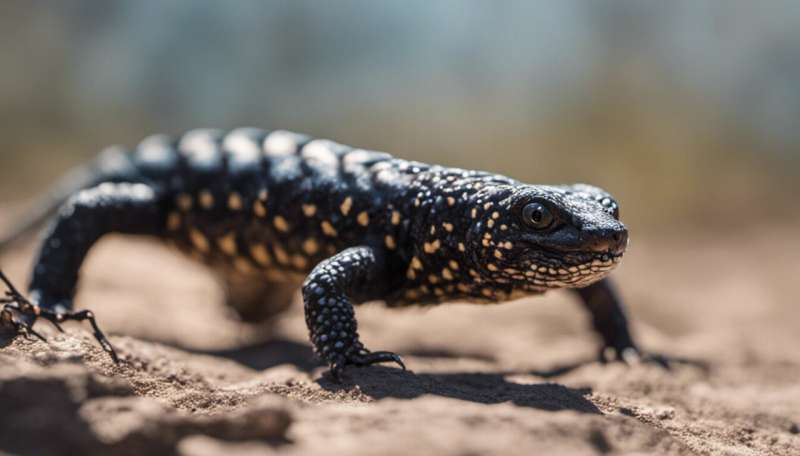This article has been reviewed according to Science X's editorial process and policies. Editors have highlighted the following attributes while ensuring the content's credibility:
fact-checked
trusted source
written by researcher(s)
proofread
Wegovy was inspired by Gila monster venom. Here are some other drugs with surprising origins

Many of the drugs we use today started their journey from bench to bedside in a computer. But this is certainly not the case for all drugs. Indeed, many have exotic origins, including the blockbuster drugs Wegovy and Ozempic, which were inspired by the venom of the Gila monster.
Scientists found that a hormone in the Gila monster's venom called exendin-4 could be used to treat type 2 diabetes. Exendin-4 is similar to a hormone found in humans called GLP-1, which is released after eating and is important for controlling blood sugar levels in humans.
Research into extendin-4 yielded semaglutide, a derivative of the molecule but one that will stay in the body for far longer, producing the desired pharmacological effect. And that's how Wegovy and Ozempic, which both contain semaglutide, came into being.
The Gila monster is not the only reptile to inspire groundbreaking drugs. Indeed, the venom of the Brazilian pit viper inspired a class of drugs known as ACE inhibitors.
In the late 1960s, researchers were studying this snake's venom and its effects on blood pressure. They isolated a peptide from the venom, which could inhibit an enzyme called angiotensin-converting enzyme (ACE) and lead to a decrease in blood pressure. This resulted in the development of a synthetic version of the peptide being created called captopril.
Although captopril is rarely prescribed today, it led to the next generation of ACE inhibitors, such as enalapril, which are widely prescribed to treat high blood pressure and heart failure.
Venoms from both land and sea creatures provide a rich source of medicinal compounds. Cone snails are known for producing a variety of venom peptides that they use to immobilize their prey. A synthetic version of one of the peptides found in their venom is used in the painkilling drug ziconotide.
Another sea creature, the Caribbean sea squirt, has provided us with the anti-cancer drug trabectedin. Studies conducted with trabectedin showed positive results in treating advanced soft-tissue cancers, such as liposarcoma and leiomyosarcoma. In 2015, the U.S. Food and Drug Administration granted accelerated approval for trabectedin for treating these cancers in patients with advanced soft tissue cancer who failed to respond to chemotherapy.
Anticoagulants
Medical leeches have also provided humanity with life-saving drugs. When these creatures latch on to a person to suck their blood, they inject compounds such as hirudin and calin to stop their victim's blood from clotting.
The anticoagulant drugs bivalirudin and desirudin are derived from hirudin. These drugs are given to people at a high risk of getting blood clots—such as those with atrial fibrillation, a type of heart arrhythmia. If a blood clot jams up an artery, it can cause a stroke or heart attack.
The story of another anticoagulant called warfarin dates back to the 1920s when cattle in the U.S. and Canada began dying from a mysterious bleeding disorder. It turned out that the cause was the moldy sweet clover hay the cattle were eating. The harmful compound in the mold that caused the bleeding, called dicoumarol, was eventually developed into warfarin.
Warfarin was initially sold as rat poison as it was so effective at causing internal bleeding in rodents. However, researchers soon realized its potential therapeutic use in humans as an anticoagulant. The drug really took off in 1955 after U.S. president Dwight Eisenhower was successfully treated with it following a heart attack.
Explosive finding
Nitroglycerin was first discovered in the 19th century, and is derived from glycerol where its explosive properties were initially noted. However, its medicinal properties were soon recognized.
Middle-aged men who worked with explosives—such as those building the rail networks—would sometimes note that their chest pain subsided after handling sticks of dynamite. Medical researchers got wind of this story and developed nitroglycerin into a drug to relieve angina symptoms by dilating the blood vessels and improving blood flow to the heart.
The drug is still used today and is known for the annoying side-effect of triggering explosives scanners at airports.
Finally, there is chemotherapy. We have the deadly chemical warfare agent mustard gas to thank for this. During the first world war, scientists noticed that mustard gas destroyed lymphatic tissue, they wondered if it might destroy cancer cells in lymph nodes. But it wasn't until the 1940s that nitrogen mustard (a derivative of mustard gas) was first used to treat a patient with blood cancer. Several drugs derived from mustard agents were subsequently developed.
While modern drugs will continue to be mostly designed on computers—and, increasingly, artificial intelligence—drug researchers will continue to look for inspiration for new meds in weird and wonderful places.
This article is republished from The Conversation under a Creative Commons license. Read the original article.![]()


















